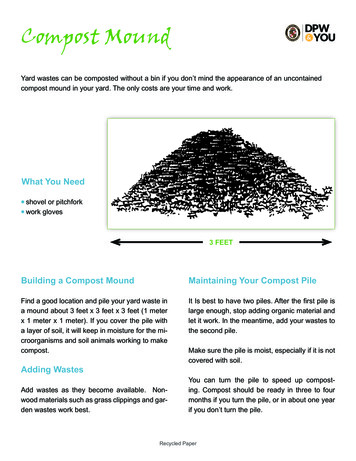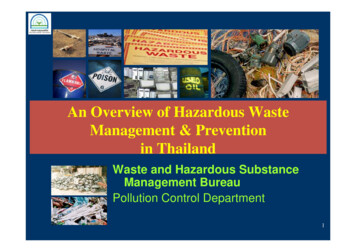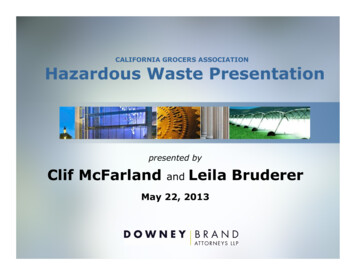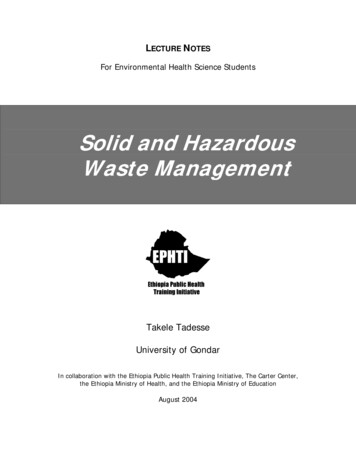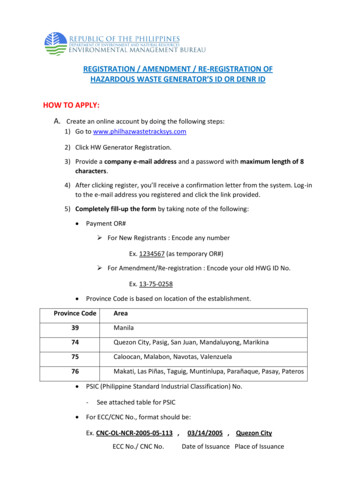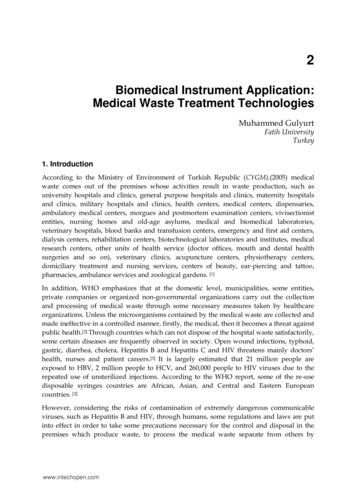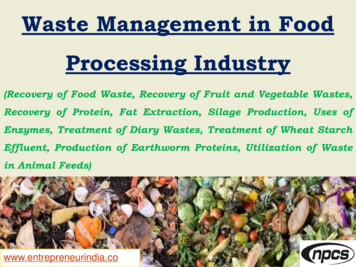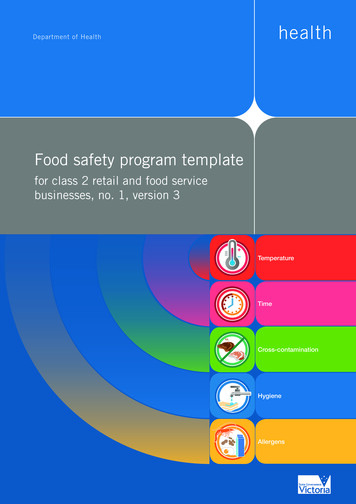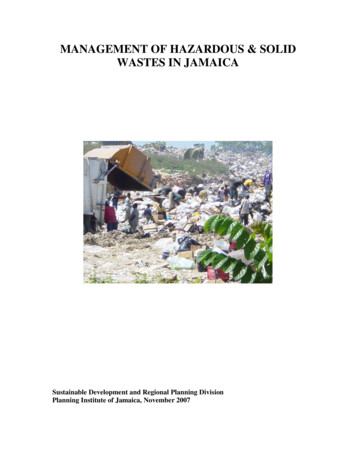
Transcription
MANAGEMENT OF HAZARDOUS & SOLIDWASTES IN JAMAICASustainable Development and Regional Planning DivisionPlanning Institute of Jamaica, November 2007
IntroductionThe Barbados Plan of Action for Small Island Developing States (SIDS) identifies themanagement of wastes as a critical issue in achieving sustainability. Worldwide, wasteproduction is growing with significant increases in developing countries. Over the past 30years, the generation of solid waste per capita in Latin America and the Caribbean (LAC)has doubled, increasing from 0.2-0.5 kg/day to 0.5 to 1.0 kg1. In Jamaica, for instance,there has been a 50 per cent increase in the per capita generation of solid waste in the last5 years alone, moving from 1 kg to 1.5 kg2 . There has also been a change in thecomposition of waste with more non-biodegradable and hazardous waste which aredetrimental to human and environmental health. In general the country’s changing socioeconomic and demographic variables have been influencing both the type and quantity ofwaste being produced. These factors include population size and structure; consumptionpatterns and lifestyles; changes in household size and composition; changing genderroles; urbanization and shifts and expansion of economic activities.Researchers contend that there is a positive relationship between economic activity asmeasured by Gross Domestic Product (GDP) and the volume of waste produced. Thehigher the per capita GDP of a country, the higher the quantity of waste produced(Stanners and Bordeau, 1995; European Environment Agency, 2000). Generally middleto high income countries have a higher per capita waste generation than low income ones.In the case of Jamaica, per capita GDP has been on an upward trend and is expected tocontinue in light of the Government of Jamaica (GOJ) plans for the country to achievedeveloped country status by 2030. The type of development path chosen will alsoinfluence the type and volumes of waste produced.Currently, the proper management of waste is posing a serious challenge to Jamaica’ssustainability. One of the main problems is that like many other developing countries,Jamaica lacks the technical and financial resources to adequately manage waste. This has1UNEP Global Environment Outlook, 2000Estimated from Waste Characterisation Study at the Riverton Landfill, National Solid Waste ManagementAuthority, 2006.22
resulted in inefficient and inadequate collection, treatment and disposal. This problem isfurther exacerbated by the lack of a comprehensive and integrated waste managementpolicy. Another challenge relates to the complexities brought about by the different typesand nature of wastes with which the country has to contend.Although there have been a number of initiatives to improve the management of wastes,these have been inadequate and fragmented. The purpose of this paper is to provide abrief review of solid and hazardous waste management within the country and assessfuture challenges, especially in light of the Government of Jamaica’s (GOJ) plans for thecountry to achieve developed country status by 2030 and the impact this will have on thegeneration and management of wastes.Section 1 describes the solid and hazardous waste management system.Section 2identifies factors affecting solid waste generation. Section 3 discusses economic, socialand environmental dimensions of waste management. Section 4 discusses the futurechallenges and management goals for solid and hazardous waste management.3
1. Overview of Waste Management SystemJamaica produces all types of wastes which include gaseous emissions, solid andhazardous waste and sewage.This paper focuses on the management of solid andhazardous waste in Jamaica.Solid WasteSolid waste is broadly defined as non-hazardous, industrial, commercial and domesticrefuse including household organic trash, street sweepings, hospital and institutionalgarbage, and construction wastes. In 2006, approximately 1 463 905.5 tonnes3 of solidwaste were produced from residential, commercial and institutional sources. Over thepast decade there has been a 150 per cent increase in per capita generation of solid wastefrom 0.6 kg/person/day (Treasure, 2002) in 1996 to 1.5 kg/person/day in 2006. Thismeans that the total volume of solid waste has more than doubled over the period movingfrom approximately 549 690 tonnes.Characterisation of the Solid Waste StreamA Waste Characterisation Study carried out by the National Solid Waste ManagementAuthority (NSWMA) in 2006 reported that 69 per cent of the solid waste produced inJamaica is organic and represents approximately 1.01 million tonnes by volume (Tables 1& 2). Between 2000 and 2006, data show that organic waste generation increased by 14percentage points. The high content of organics in solid waste is similar to otherCaribbean countries such as Trinidad & Tobago and Barbados (Table 3). This highorganic content is probably due to the consumption patterns of developing countries.3This is a crude estimate based on 1.5 kg per capita per day and a population size of 2,673,800 in 2006.4
Table 1. Percentage of Waste Generation by Type, 2000 and 2006Type of WastePercentage Percentage(Yr 2000)(Yr 2006)Compostables (Organic)PaperPlasticMetal/ TinCardboardGlassTextileWood otal100100Source: Waste Characterisation Study, NSWMA, 2006Table 2. Solid Waste Generation by Volume, /TinCardboardGlassTextileWood BoardOtherTotalPercentageVolume (tonnes)695.913.92.33.72.42.30.30.21001 010 094.886 370.5203 482.933 669.854 164.535 133.733 669.84 391.72 927.81 463 905.5Source: Compiled by the Planning Institute of JamaicaDeveloped countries have less organics in their solid waste streams and have a higherquantity of plastic and non-biodegradable material (Table 3). This is probably related tothe wealth and consumption patterns and the higher level of processed foods in developedeconomies. The generation of waste plastics in Jamaica and Trinidad & Tobago werealmost as high as in the United States of America which means that the countries arealmost on par with developed countries in consuming plastic products.5
Table 3. Comparison of Percentage Solid Waste Composition, 1999, tileMetalWood BoardOtherTotalJamaica2000551312443513100Trinidad & Tobago199946131276475100United States200019.532.814.35.73.96.99.37.6100Source: Waste Characterisation Study, NSWMA, 2000; SWMCOL, 1999, Trinidad & TobagoA high content of organics and inert material (dust, sand, dirt) in the waste stream resultsin high waste density (weight to volume ratio) and high moisture content. High wastedensities and moisture content influence the feasibility of certain treatment options(Zurbrugg, 2003). For example, incineration would not be a feasible option for wastestreams with high moisture content but composting would probably be a better option.Managing WasteThe NSWMA was established in 2001 and has the sole jurisdiction for solid wastemanagement in the country. Prior to the establishment of the NSWMA, garbagecollection was vested under the respective Parish Councils within each parish. TheNSWMA was given its legal mandate with the enactment of the National Solid WasteManagement Policy and the National Solid Waste Management Act (2002). TheAuthority currently collects, treats and disposes of domestic solid waste whilesimultaneously regulating the sector. This has proven to be difficult in light of theinadequate capacity of the NSWMA. Hence, the Authority is transitioning to a regulatorymode while contracting out collection, treatment and disposal services. The NSWMA isnot responsible for the collection, treatment and disposal of commercial, agricultural,industrial or hazardous waste; however, most non-domestic wastes end up at the disposalsites operated by the Authority.6
Figure 1 shows the elements of domestic solid waste management. Generated waste isstored and picked up by curbside collection (primary collection) or this waste istransferred to temporary storage or transfer points (skips etc.,) to be taken by secondarycollection. Being high in organics, some of the waste is composted while somerecyclable, reusable and valuable material are sorted and removed from the waste streamand sold or used by individuals (informal waste pickers or formal employees within thesolid waste management system). Most of the solid waste produced in Jamaica ends up atthe landfills. Information on quantities of solid waste recycled or re-used is not known.Waste GenerationCompostingTransfer Point(Skip)StoragePrimary Collection(Curbside)DisposalSecondary CollectionSorting and selling of valuablesReuse/recyclingFigure 1. Elements of domestic solid waste management in JamaicaCollection and disposal of solid waste is organized around wastesheds. A wasteshed is allthe areas in a region from which waste is collected and hauled to a common disposal site.There are four wastesheds comprising a total of eight dumpsites around the island (Table4). The wastesheds (including the parishes they cover) are North Eastern Parks andMarkets, Metropolitan Parks and Markets (Riverton), Southern Parks and Markets andWestern Parks and Markets (Appendix 1). Domestic solid waste represents7
approximately 70.0 per cent4 of the estimated total solid waste generated whilecommercial/industrial solid waste represents about 30 per cent (Figure 2)Industrial10%Commercial20%Domestic70%Figure 2. Percentage of Solid Waste by SourceTable 4. Active Disposal Sites Island-wide, 2006NameDisposal SiteSize (hectares)RivertonSt. Catherine43.50Church CornerSt. Thomas1.21Martin’s HillManchester7.82MyersvilleSt. Elizabeth3.7RetirementSt. James10.96TobolskiSt. Ann4.94HaddenSt. Ann3.88Doctors WoodPortlandn/aSource: National Solid Waste Management AuthorityAbout 20.0 per cent of the solid waste collected (mainly domestic) is handled by privatecollectors (SoE, 2001)5 and approximately 10.0-20.0 per cent of solid waste is notcollected by any formal system. It is an increasing trend for some upscale town-house45Estimate based on discussion with the NSWMA.State of the Environment Report, 20018
and apartment complexes, especially in the Kingston Metropolitan Area (KMA), to payprivate contractors for efficient and reliable waste collection. Most uncollected wasteends up in drains, streams, wetlands (contributing to flooding), rivers, sea, open lots andillegal dumpsites.Collection by garbage trucks and burning are the predominant methods of garbagedisposal and treatment (Figure 3). In 2006, approximately 55.0 per cent6 of Jamaicanhouseholds disposed of their garbage via garbage trucks while 38.0 per cent burn theirgarbage. However, the frequency of pickup by the trucks was not determined. Garbagecollection in the KMA and Other Towns has been more efficient than in other areas of thecountry. Collection is particularly low in rural areas where the main method of treatmentand disposal is burning (Figure 4). Other disposal methods include burying and dumpingon open lots and in gullies. While burying garbage may improve aesthetics, depending onthe type of garbage, it can be detrimental to groundwater, soil and terrestrial organisms.1%1%1%38%55%4%TruckSkipBurnBuryEmpty lotGullySource: Jamaica Survey of Living Conditions, 2006.Figure 3. Waste Disposal by Jamaican households, 20066Survey of Living Conditions 20069
90.080.070.0%60.050.040.030.020.010.00.0KMAOther TwnsRural AreaRegionGarbage TruckSkipBurnBuryOtherSource: Jamaica Survey of Living Conditions, 2006Figure 4. Main method of garbage disposal by region, 2006As much as 75 per cent of those households that burn garbage are found in rural areas(Figure 5). Burning has implications for environmental and human health as burnt wastescontain substances that give off toxic, carcinogenic gasses and substances.RegionRural AreaOther twnsKMA0.010.020.030.040.050.060.070.080.0%Source: Jamaica Survey of Living Conditions, 2006Figure 5. Households that burn garbage by region, 200610
Solid Waste Management ChallengesDespite efforts at improvement, the current capacity (institutional, personnel, financial,technology, equipment) of the NSWMA is inadequate to efficiently and effectivelymanage the increasing generation of solid waste and the changing waste stream (Table 5).Additionally, the Authority is burdened by the dual and conflicting role it has to play ascollector and regulator.Table 5: Initiatives in Solid Waste Management in JamaicaSolid WasteActions Being TakenDraft Sanitation PolicyActions Already TakenEnactment of Solid Waste Management Act andPolicyDraft NSWMA Business and Cost Recovery PlanTraining of relevant staff in landfill managementtechniquesExploring new sites to relocate some landfillsUse of biodegradable garbage bagsEstablishment of NSWMA to manage domesticsolid wasteTwo Waste Characterisation studies done inRiverton WasteshedIDB Waste study done. Recommends closure ofwaste disposal sites in environmentally andsocially sensitive areas.Improved infrastructure at Riverton (accessroads, office, perimeter fencing) through IDBSolid Waste ProjectSource: Compiled by the Planning Institute of JamaicaJudging from the size of the fleet and volume of waste to be moved, NSWMA’s capacityfor transporting waste is limited. An estimated 4010.7 tonnes of solid waste are generateddaily in Jamaica. One garbage truck carries approximately eight tonnes7 of garbage pertrip and makes an average of two trips to the disposal site per day. Hence, an average of7Estimate based on data from the NSWMA.11
250 trucks8 would be needed to efficiently dispose of garbage across the island on a dailybasis. The estimated number of trucks needed by the NSWMA to collect and dispose ofdomestic solid waste would then be about 175. Currently, the number of trucks availableto the NSWMA (both government owned and contracted) total 145 (Table 6). This is 30trucks less than the estimated effective fleet (Figure 6).Table 6. Number of trucks by Wasteshed, 2006WasteshedParishMetropolitan Parks & MarketsKingston & St. AndrewSt. CatherineClarendonSt. ThomasManchesterSt. ElizabethWestmorelandTrelawnyHanoverSt. JamesSt. AnnPortandSt. MarySouthern Parks & MarketsWestern Parks & MarketsNorth-Eastern Parks & MarketsTotalNumber oftrucks73173916145Source: National Solid Waste Management Authority, 2007The inadequacy of the fleet size is significant in the MPM Wasteshed. It is estimated thatthe Riverton Disposal site receives about 60.0 per cent of the solid waste generated whichis about 2406.4 tonnes per day. Therefore, it requires approximately 150 trucks toadequately collect and dispose of solid waste within this wasteshed. The MPM wouldneed approximately 105 trucks to move domestic garbage within the KMA but currentlythe fleet size is 73 (Figure 6). The inadequate fleet size has affected the frequency ofgarbage collection and the problem is compounded by the long downtime (for repairs) ofmany of the trucks. Another problem is the sometimes long distances the trucks have to8This figure represents a crude estimate of the total trucks needed to collect both commercial and domesticwaste. Operational aspects are not taken into account.12
travel to pick up garbage. This increases the cost of collection and disposal, as well asmaintenance cost of the fleet.12010080Fleet size 6040200ActualEstimatedFigure 6. Comparison of Actual and Estimated Fleet Size for Domestic Solid Wastein the KMAMany communities, especially informal ones, are without curbside collection. This iscompounded by the fact that there has been a proliferation of squatter communitiesespecially in urban areas. In areas lacking curbside collection, skips are often providedbut these are sometimes insufficient to collect the volume of solid waste being generated.Although the NSWMA has the legal mandate to enforce proper garbage disposalmethods, inadequacy in enforcement has been a perpetual problem. The absence ofproper methods/technology to deal with certain wastes such as electronic waste (e-waste)makes enforcement of legislation difficult. Additionally, the Authority lacks adequatetechnical personnel to effectively manage wastes. Also the inability of the Authority toeffectively manage its landfills and control illegal ones has lead to increased informaldumping of solid waste. For example, commercial entities are responsible for thecollection and disposal of their own solid waste. However, weak capacity to police themresults in illegal dumping being a prevalent problem.13
Poor location of disposal sites is another major challenge in waste management.According to a study conducted by IDB in 1999 most of the official dumpsites arelocated in socially and environmentally sensitive areas and there is a proliferation ofillegal dumpsites across the country. The problem is made worse by the inadequateenforcement of relevant legislation pertaining to littering and disposal of solid waste.Furthermore, there are no sanitary landfills in Jamaica (National Solid Waste Policy,2001) which have socio-economic and environmental implications.Since the most common method of waste treatment and disposal in Jamaica is landfilling,the availability of land to deal with increasing volumes of waste becomes an importantissue. Currently, the level of compaction at the disposal site is quite low due mainly tolack of equipment and this has resulted in a greater need for land space to store garbage(NSWMA, 2007). This is compounded by the increasing volumes of non-biodegradablewaste which can persist at disposal sites for a very long time. The KMA produces about50.0-60.0 per cent of the quantity of solid waste which is deposited at the Riverton CityLandfill (IDB, 2000). It is estimated that within five to seven years this site will reach itsmaximum capacity (by 2014). This has implications for the deposition of municipalwaste given the difficulty to find suitable land for an alternative site.Apart from the operational factors directly related to the NSWMA, social practices alsoimpinge on the efficiency of waste management. For example, there is negligibleseparation of solid waste which often has recyclable and re-useable (valuable) materialsmixed with other types of garbage. The crushing together of garbage in this manner hasthe potential for hazardous materials to get dispersed through thousands of tonnes ofgarbage at the landfill site.Hazardous WastesWaste that is hazardous has properties that make it dangerous or potentially harmful tohuman health or the environment (United States Environmental Protection Agency,2006). Hazardous waste can be liquids, solids, contained gases, or sludges or by-products14
of manufacturing processes or simply discarded commercial products like cleaning fluidsor pesticides (Table 7).The volume of hazardous waste generated bears some relationship to the level ofindustrialization in a country (National Research Council, 1985). With modernizationand diversification of the Jamaican economy and increasing mechanization of processesin sectors which were once driven manually (such as in agriculture), there has been asteady increase in the generation of hazardous wastes (SoE, 2001). While, comprehensivedata is lacking on the actual quantities and types being produced, the SoE Report, 2001noted that about 10,000 tonnes of hazardous wastes are produced annually with wasteengine oil comprising as much as 80.0 per cent. The Ministry of Local Government andEnvironment (MLGE) estimates that about 500,000 lead acid batteries are generatedannually with only about 30.0 per cent being collected and exported for recycling. Theincreasing generation of waste oil and lead acid batteries are directly related to theincreased importation of motor vehicles into the island.Table 7. Sources and Types of Hazardous Waste in ldMedicalMain types of hazardous wasteSolvents, thinners, toxic gasses, heavy metals,asbestos, glues and resins, e-waste, waste oil,particulate matterPesticidesE-waste, toners, waste oil, paints, asbestosCleaners, disinfectants, paints, drugs, batteries, ewasteDrugs, radioactive material, contaminated needles,syringes, bandages, bodiesSource: Compiled by Planning Institute of JamaicaAmong the categories of hazardous waste which are likely to pose a significant challengein the near future are medical and e-waste. The former is defined “as any waste that isgenerated in the immunization, diagnosis, treatment and disposal of human beings oranimals or parts thereof, in research pertaining thereto, or in the production or testing ofbiologicals”. Medical waste is generated as a result of activities relating to the practice of15
medicine and sale of pharmaceuticals. This type of waste may be radioactive, toxic orinfectious or similar in nature to normal domestic waste. Increasing incidents of chronicillnesses relating to lifestyle are resulting in the generation of more hazardous medicalwaste due to the type of treatment required. Government policies involving freehealthcare could lead to increase in medical waste and site-specific concentration of thiswaste due to increased influx of people to public healthcare facilities. This poses potentialchallenges for the management of medical waste by healthcare facilities.Electronic waste (e-waste), for example used electronic and electrical appliances, consistof a variety of different parts made from hundreds of different substances includingplastics, metals, glass as well as organic and inorganic compounds. While some of theseparts can be recycled, others need special treatment and disposal systems. Morepotentially hazardous and diversified e-wastes are being generated with the liberalizationand continued expansion of the Information and Communication Technology (ICT)sector. The magnitude of the impact of growth of waste for this sector is demonstrated bythe change in the profile of this sector. For example, Jamaica’s mobile penetration standsat 93.3 per cent (Economic and Social Survey Jamaica, 2006) representing a ten foldincrease in the number of cellular phones over 2000. Apart from changes in cell phonetechnology, the cell phone is for some a fashion item to be discarded and replaced. Therebeing no formal facility for the treatment of hazardous waste, the country has a seriouschallenge in dealing with used instruments.There is currently no comprehensive mechanism or policy for the management ofhazardous wastes in Jamaica although some initiatives have been and are being taken toestablish such a system (Table 8). The absence of facilities for the treatment and disposalof hazardous waste means that most hazardous waste is deposited in the normal wastestream ending up at landfills or in the sea. For instance, chemicals, waste paints andwaste oil are usually poured down drains, gullies and in some cases just thrown on land.Inadequate regulation of garages has made this problem worse with the inappropriatedisposal of waste oil and other toxic substances. Some of these garages are found close toresidences.16
It is uncertain how much of hazardous wastes are recycled by industry and while somecompanies take back used cell phones (especially as a marketing strategy) the extent ofrecollection schemes are unknown. It is also not known how these companies dispose ofused instruments.Table 8. Current Initiatives in Hazardous Waste Management in JamaicaHazardous wasteActions Being TakenActions Already TakenNational programme for chemicals and WasteJamaica signatory to Basel, Rotterdammanagement in Jamaica started.Conventions and the Stockholm Convention onPersistent Organic Pollutants (POPs)Initiation of Integrated National Programme(INP) for the sound management of hazardous Creation of a National Information exchangewastesmechanism in the form of a websiteDevelopment of an Inter-ministerialCoordination Mechanism (ICM)Development of policy framework for themanagement of hazardous wastesUsed Lead Acid Battery (ULAB) projectcompleted. About 50,000 batteries have beenexported for recyclingRegistration of importers of pesticides andlicensing of pest control operatorsInventory of hazardous chemicalsOngoing development of guidelines forstorage of batteries, computer waste, agrowaste and phosphatesIncrease in the number of workshops given toindustries on clean technologies.Draft Policies on Medical Waste andSanitationSource: Compiled by the Planning Institute of Jamaica17
2. Factors Affecting Waste GenerationA number of socio-demographic, economic and environmental factors affect the volumeand type of solid and hazardous waste generated. These factors include populationgrowth and urbanization, consumption patterns and lifestyles, household size, changinggender roles, size of the working age group of the population, economic expansion,globalization, government policy, and urbanization.Socio-demographic FactorsPopulation Growth & UrbanizationThe quantity of solid waste increases with population growth. As mentioned before, witha 6.5 per cent increase in population from 1996 to 2006, Jamaica’s solid waste productionhas more than doubled. While the overall population has been growing at less than onepercent per annum, most of the growth is being experienced in urban centres and towns(urbanization) through urban in-growth and urban-urban and rural-urban drift. Theregional distribution of the population can also determine the quantity and type of solidwaste produced. For example, urban areas may produce different types of wastes thanrural areas. The predominantly agricultural base and lower economic status of most ruralareas result in a high proportion of organics and biodegradable waste.The mass movement of people from rural areas to urban areas results in the generation ofmore wastes (municipal wastes) in urban centres. Urbanization is a global phenomenonand is especially occurring in developing countries. It is estimated that by 2008, 3.3billion people will live in urban centres and increase to 4.9 billion9 by 2030. ThroughoutJamaica, the urban population has jumped from 30 per cent in the 1960s to 52 per cent in2006, totalling 1.39 million people. Major towns such as Santa Cruz and May Pen and theparish of St. Catherine, have seen exceptional growth.9United Nations World Population Fund, State of World Population 200718
The growth in urban population has also coincided with a rise in informal settlements dueto scarcity of housing and unregulated developments. This puts further burden on thesolid waste management services offered by government. Often these settlements areconstructed in such a way that makes access by garbage trucks difficult. Some of thesesettlements lack certain amenities like proper sanitation that create more wastes. Due tocompeting priorities for land use in urban areas, finding adequate and suitable disposalfacilities is very challenging and often leads to social conflicts. Urbanization trends arenot expected to abate. However policymakers must be aware that that while urbanizationcan cause negative impacts; it may offer sustainable opportunities in adequate solid wastemanagement by allowing greater access and ease of providing efficient services todensely populated areas.Household SizeThere is some evidence that smaller households generate more wastes per person (percapita) than large households due to more per person consumption (Orians & Skumanich,1997; Beigl et al, 2004). Also, the demand for convenience has increased with theincreasing numbers of single person households, especially in urban areas resulting inmore packaging waste and the demand for convenience food. The average household sizein Jamaica has decreased from four to three over the past 10 years (1996-2006)10 (Figure5). The number of households containing no more than three persons rose byapproximately 9 percentage points for the same period and single persons householdrepresented the largest distribution in 2006 (24.2%). It is expected that average householdsize will continue to decrease in the future, especially with effective family planning,education and increasing standard of living. Decreasing household size coupled withpopulation growth and improved economic status could lead to a greater demand forhousing resulting in the generation of greater volumes of construction waste.10Jamaica Survey of Living Conditions 200619
Mean h'hold size 022003200420052006YearSource: Jamaica Survey of Living Conditions, 2006Figure 5: Mean household size in Jamaica, 1996-2006Age StructureStudies have shown that there is a positive relationship between the working age group ofa population and the volume and type of solid waste produced (Lindh, 2003; Beigl et al,2004). The larger the working age population, the more they will consume different typesof products providing they have access to income. Persons within the age group 15-64(working age) represented approximately 63.4 per cent11 of the population in 2006 andthis relative proportion is likely to remain for some time into the future. In factprojections using the Threshold-21 (T-21) model show that persons of working age willrepresent 66.0 percent of the total population in 2030. The unemployment and povertyrates are also falling being 10.3 per cent and 14.3 per cent respectively in 2006. Thiscould fuel increased consumption for the future and lead to the generation of more andvaried solid waste.Changing gender rolesResearch has found a link between increasing proportion of women in the workforce andsolid waste generation mainly linked to convenience consumption (Orians & Skumanich,11Economic and Social Survey, Jamaica, 200620
1997). Increasingly, more women are being educated and opting to join the workforce.Women currently make up approximately 42.0 per cent 12 of the Jamaican workforce andwith increasing education man
Comparison of Percentage Solid Waste Composition, 1999, 2000 Jamaica Trinidad & Tobago United States Category 2000 1999 2000 Organics 55 46 19.5 Paper 13 13 32.8 Plastics 12 12 14.3 Cardboard 4 7 Glass 4 6 5.7 Textile 3 4 3.9 Metal 5 7 6.9 Wood Board 1 9.3 Other 3 5 7.6 Total 100 100 100 Source: Waste Characterisation Study, NSWMA, 2000; SWMCOL, 1999, Trinidad & Tobago A high content of .
